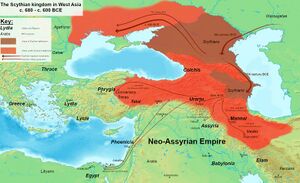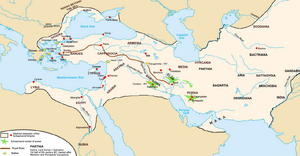Urartu
| Author:Laxman Burdak, IFS (Retd.) |


Urartu ( Hebrew:Ararat) was an Iron Age kingdom centred on Lake Van in the Armenian Highlands.
Variants
- Ararat (Anabasis by Arrian, p. 411.)
Location
The landscape corresponds to the mountainous plateau between Asia Minor, Mesopotamia, and the Caucasus mountains, later known as the Armenian Highlands. The kingdom rose to power in the mid-9th century BC, but was conquered by Media in the early 6th century BC. The heirs of Urartu are the Armenians and their successive kingdoms.
History
Assyrian inscriptions of Shalmaneser I (c. 1274 BC) first mention Uruartri as one of the states of Nairi – a loose confederation of small kingdoms and tribal states in Armenian Highland in the 13th to 11th centuries BC which he conquered. Uruartri itself was in the region around Lake Van. The Nairi states were repeatedly subjected to further attacks and invasions by the Assyrians, especially under Tukulti-Ninurta I (c. 1240 BC), Tiglath-Pileser I (c. 1100 BC), Ashur-bel-kala (c. 1070 BC), Adad-nirari II (c. 900), Tukulti-Ninurta II (c. 890), and Ashurnasirpal II (883–859 BC).
Urartu re-emerged in Assyrian inscriptions in the 9th century BC as a powerful northern rival of Assyria. The Nairi states and tribes became a unified kingdom under king Aramu (c. 860 – 843 BC), whose capital at Arzashkun was captured by the Assyrians under Shalmaneser III. Roughly contemporaries of the Uruartri, living just to the west along the southern shore of the Black Sea, were the Kaskas known from Hittite sources.
According to Urartian epigraphy, Sarduri III was followed by three kings—Erimena (635–620 BC), his son Rusa III (620–609 BC), and the latter's son Rusa IV (609–590 or 585 BC). Late during the 600s BC (during or after Sardur III's reign), Urartu was invaded by Scythians and their allies—the Medes. In 612 BC, the Median king Cyaxares the Great together with Nabopolassar of Babylon and the Scythians conquered Assyria after it had been badly weakened by civil war. Many Urartian ruins of the period show evidence of destruction by fire. This would indicate two scenarios—either Media subsequently conquered Urartu, bringing about its subsequent demise, or Urartu maintained its independence and power, going through a mere dynastic change, as a local Armenian dynasty (later to be called the Orontids) overthrew the ruling family with the help of the Median army. Ancient sources support the latter version: Xenophon, for example, states that Armenia, ruled by an Orontid king, was not conquered until the reign of Median king Astyages (585– 550 BC) – long after Median invasion of the late 7th century BC.[1] Similarly, Strabo (1st century BC – 1st century AD) wrote that "[i]n ancient times Greater Armenia ruled the whole of Asia, after it broke up the empire of the Syrians, but later, in the time of Astyages, it was deprived of that great authority ..." [2]
According to the Encyclopedia of Indo-European Culture:
- The Armenians according to Diakonoff, are then an amalgam of the Hurrian (and Urartians), Luvians and the Proto-Armenian Mushki who carried their IE language eastwards across Anatolia. After arriving in its historical territory, Proto-Armenian would appear to have undergone massive influence on part the languages it eventually replaced. Armenian phonology, for instance, appears to have been greatly affected by Urartian, which may suggest a long period of bilingualism.[3]
Jat History
- Beniwal: Bhim Singh Dahiya writes about the kingdom of Ven, on Lake Van in Turkey in the tenth century B.C. They are the Benae of the later Greek writers, the Beniwal or Venhwal clan of the Jats in India, whose king, Raja Chakravarti Ben/Ven. (the Chakva Ben) is famous in Indian legends from the Punjab to Bengal, without rinding a place in the present-day history. Significantly, the Ven kings, took the title of “king of kings”, “king of the world”—titles which were later taken up by the Achaemenians of Iran. In addition, the Ven kings are called, “The king of the Biainas” and “king of the Naire”. These titles show that the Ven kingdom, included the Bains and Nara clan of the Jats. Again, the Ven kings, extended their power over the Manna/Mannai and the Dayeni/Dahi people. [4]
- Nehra: According to Bhim Singh Dahiya they are to be identified with Nara or Nehra clan of the Jats, the Nairi of West Asia. Assyrian inscriptions of Shalmaneser I (ca. 1270 BC) first mention a loose confederation called the Urartu or Nairi in North-East Anatolia, in the region around Lake Van. [5]
- Manda Empire: Bhim Singh Dahiya writes that Assurbanipal died in 626 BC, and his successors were disputing the throne. Such an opportunity was not to be lost and second attack of Nineveh began. The Assyrian Emperor burnt himself in his palace and perished with his family. Thus in 606 BC, Nineveh fell and so utter was its ruin that the Assyrian name was forgotten and the history of their empire soon melted into fable. [6] Armenia and Cappadocia were including in the Manda Empire. Lydia was emerging as a powerful nation in the west and it was inevitable that the two powers should collide. The war began but in 585 BC, when there was a total eclipse of the sun; and it was stopped after six years of fighting, under a peace treaty. A daughter of the Lydian emperor was married to the heir apparent of Manda, and the kingdom Urartu was annexed to Manda empire. Next year, i.e. 584 BC, this great emperor died. Thus, from a beaten nation he raised the Mandas into the most powerful and virile empire of that time. It is aptly stated that the east was Semitic when he began to rule but it was Aryan when he stopped. This leader in one of the great moments in history was succeeded by Ishtuvegu, Astyages of the Greeks. He was an unworthy son of a worthy father, and he deviated from the basic policy of the Mandas, i.e. to keep fit and ready for war. He had no son and his daughter named Mandani (after the clan name) was married to a small vassal prince of Elam. [7]
External links
References
- ↑ Xenophon.Cyropedia. 3.7. Translated by Henry Graham Dakyns.
- ↑ Strabo. Geography. 11.3.5
- ↑ “Armenians” in ""Encyclopedia of Indo-European Culture or EIEC, edited by J. P. Mallory and Douglas Q. Adams, published in 1997 by Fitzroy Dearborn.
- ↑ Jats the Ancient Rulers (A clan study)/Introduction, p.ix
- ↑ Bhim Singh Dahiya: Aryan Tribes and the Rig Veda, ( 1991) ,
- ↑ Bhim Singh Dahiya, Jats the Ancient Rulers, p. 130
- ↑ Bhim Singh Dahiya, Jats the Ancient Rulers, p. 131

